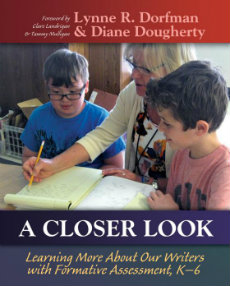A Deeper Look at Assessing Kids’ Writing
A Closer Look: Learning More About Our Writers with Formative Assessment
By Lynne Dorfman and Diane Dougherty
(Stenhouse Publishers, 2017 – Learn more)

Whether you are new to working with young writers in your classroom or you’re hoping to breath new life into your current writing teaching practice, A Closer Look: Learning More About Our Writers with Formative Assessment provides insight into an area that can often be glossed over during the teaching of writing: Formative Assessment.

When a classroom is driven by formative assessment and there is constant back and forth between the teacher and the student about writing, Dorfman and Dougherty argue the students ultimately become more reflective about their own writing practices. This is especially crucial when considering this book focuses on students as young as kindergarten.
New and Old Favorite Formative Assessments
One of the great strengths of this book is that the authors do not completely recreate what works in a writing workshop classroom. For example, there are chapters devoted to conferences, rubrics and checklists, self-assessment, surveys and inventories, and anchor charts. If you are unfamiliar with these elements, then this book is a great introduction to these pillars of writing practice. If you currently have these elements embedded in your teaching, then this book provides guidance to refine and grow your understanding.
I tend to use checklists and rubrics as summative assessments, even when introducing them at the beginning of a unit, but I appreciated the book’s explanation and examples of how to use them as formative assessments through the writing process.
Dorfman and Dougherty recommend that after reading mentor texts for a particular writing genre, work with your students to create a rubric highlighting the qualities of a good piece of writing. How does this rubric creation work as a formative assessment? Noticing and recording which students contribute to the design and what type of information is contributed – or not – can help guide further instruction.
Similarly, I tend to think of self-assessments as coming at the very end of a piece of writing or at the creation of a portfolio for the end of a semester. Dorfman and Dougherty view self-assessment as a way to teach students “how to learn instead of what to learn” (122). They then provide a variety of ways to help students engage in self-assessment: self-conferences, checklists at different times in the writing process, surveys, portfolios, and goal setting. I was already familiar with goal setting and portfolios, but to broaden self-assessment out to include surveys, self-conferences, and checklists gives my students and me more opportunities to reflect.
Conferences: The Heart of Writing Workshop and Formative Assessments
What I think I appreciate most about this book is that Dorfman and Dougherty devote three chapters to the central component of writing workshop: conferences. Conferences are where most formative assessments take place, and there are individual chapters devoted to roving conferences, teacher and student conferences, and peer conferences.
Each chapter features sample student conferences, provides questions the teacher can ask the students for different areas of focus, and explains how to keep track of what occurs during these conferences to better inform your instruction.
At the end of the day, I want to do what is best for my students, and it is difficult to keep organized with the amount of information that you can collect through conferences and other formative assessments. Dorfman and Dougherty provide some great organization tools, along with other ways to help your students stay engaged and reflective of their learning.
Whether it’s a simple exit slip, a tweet, or having your students categorize themselves as leaders or learners after a day of conferences, Chapter 9 provides ways to help you stay informed about your students’ learning, highlights information to share with parents, and helps you match what you are doing to standards and different accountability measures.
Bottom Line
If there is one area most teachers could “beef up” their knowledge and instruction in the writing classroom, I would argue it is definitely formative assessment. This book is easy to read and provides ideas you can implement tomorrow in your classroom.
As the title suggests, this is written for K-6 classrooms, and it does include information at each of these grade levels. If your middle grade levels are attached to an elementary school, then this book will be especially helpful to see how formative assessments can be used with writing across each year of learning.
Benjamin Boche is an assistant professor of literacy education. He is a former middle school teacher who thoroughly enjoys the writing workshop model and loves to see the growth that can occur in students through the process. He can be found on Twitter @bennyboche where he is more of a lurker of his favorite children’s lit authors and other literacy professionals.


































